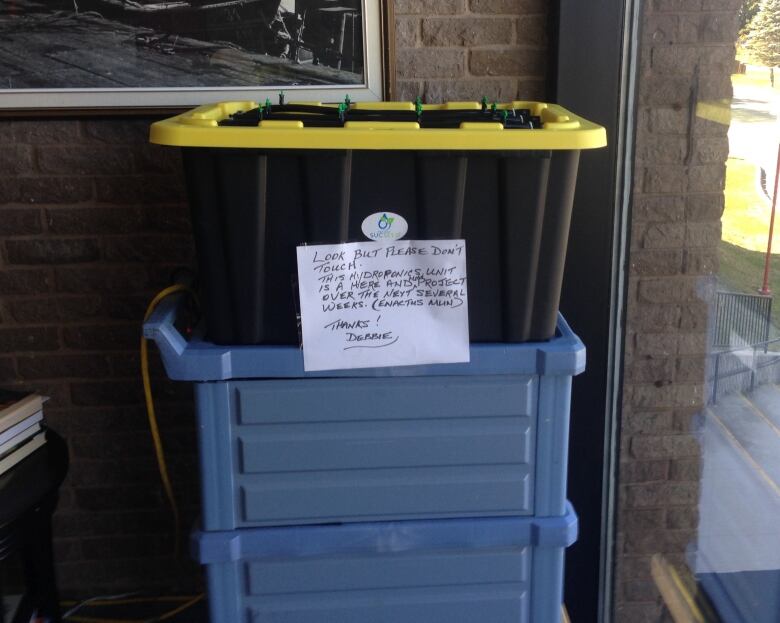Award winning project from MUN students aimed at bringing fresh vegetables to the North and elsewhere
The little hydroponics project that keeps growing and growing.

It seems to be a surprisingly simple contraption. Take a plastic Tupperware container and put some growing medium and water in it. Plant lettuce, peppers, spinach, and other types of seeds in the medium, and sit back and wait. Five to nine weeks later, you've got a harvest of fresh produce.
This ingenious tank has won some students at Memorial University a prestigious award -- a world championship: The Enactus World Cup, in Toronto on September 30.
The students are proud of their win, but more of theirproject, dubbed Sucseed, for what it can do.

"Anything can really be grown (in it)," says Abbie Ricketts one of the students who is part of the project.
Everything you will need to grow for a year.- Abbie Ricketts, project participant
"We've had peppers, strawberries, kale, broccoli and spinach."
"The only thing they don't recommend you grown in a hydroponic system," says Ricketts, "are root vegetables."
She says they will grow, but it will take a really long time. "And they will come out looking a little bit weird," added Ricketts.
"But everything else is fair game."
What makes this system special?
Hydroponics is nothing new. There are other hydroponics systems on the market.
"But they are typically going to be a lot smaller or a lot bigger, and cost a lot more," says Emily Bland, president of Enactus Memorial.
"It the social impact behind this," says Bland
And it's the social aspect of the project that won the Memorial students the award.
It's a hydroponic system that can be used in the North, other remote areas, and for co-ops of other groups to grow vegetables to eat or sell.

"These systems are made by at-risk youth at Choices for Youth," Bland says.
"It's their job to come down everyday and build these systems, and," she adds, "every system that is sold to the public, also funds one for a northern community."
The core of this project is actually food security in the North.- Emily Bland, project participant
They can grow hundreds of pounds of produce a year. "One harvest can give you about 80 tomatoes," says Bland. "It depends on how green your thumb is."
"The core of this project is actually food security in the North." says Bland. "Not only do you get the social impact of creating a job for a young person (in St. John's, it also helps feed a community up north."
The units are $300, and come with the tub, pump, nutrient pack, seeds, and, what's called Rockwool. It's a small square of material that you split open and place the seed inside. It holds the moisture and nutrients that allow the seed to grown.
"Everything you will need to grow for a year," says Ricketts.
There are 12 of the hyroponics growing tanks in co-ops around the province.
"Rigolet, Postville, St. John's, Grand Falls-Windsor, and those are just a few," says Ricketts.
Project getting much bigger
But there are many more in the province. And they are in 26 communities spread across the country. More than 200 of the hydroponic units are in operation.
You can find them in Vancouver, Toronto, Halifax, Quebec City, and, rather surprisingly, the Annapolis Valley in Nova Scotia, which is known for its fertile soil.
It's a project that just keeps steamrolling. Even Tim Hortons has jumped on this bandwagon. The company, that's better known for its coffee and donuts, has put up money to have the hydroponic tubs in 60 schools in Newfoundland and Labrador.

It's a pilot project, and if it Sucseed(s), pun intended, Tim's plans to spread the message by putting the tubs in schools across the country.
Before that even happens, they are already in six schools in New Brunswick.
And there's more. Bland says they have five of the hydroponic units in five retirement homes in NL, and one in a retirement home in New Brunswick offering horticulture therapy. She says they even have one at the penitentiary in St. John's.
Rickett's says, "They are in soup kitchens and food banks giving them a way to decrease their costs in purchasing produce."
There were 35 Enactus teams from around the world in Toronto this past September presenting their community based projects.
Memorial's Enactus team is made up of students from the business administration, humanities and social sciences, engineering and science faculties. As well as winning this year, Memorial also won in 2008.












_(720p).jpg)


 OFFICIAL HD MUSIC VIDEO.jpg)
.jpg)



























































































